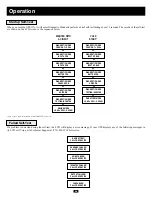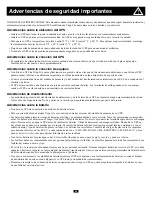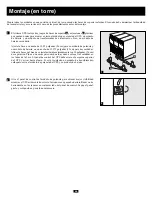
I/P
BYPASS
BATTERY
AC/DC
DC/AC
O/P
OFF
ON
MUTE
SELECT
SETUP
10
Manual Bypass Operation
(for power module maintenance or replacement)
The UPS system includes a self-contained power/battery module along with an independ-
ent, detachable PDU with a bypass switch. This switch allows qualified service personnel
to remove the detachable PDU from the power/battery module for routine maintenance
without disrupting power to connected loads. While this switch is set to “BYPASS”, con-
nected equipment will receive unfiltered AC utility power, but the equipment will not
receive battery power in the event of a blackout.
Note: If desired, an optional hardwire detachable PDU is also available separately from
Tripp Lite. Contact Tripp Lite for details.
WARNING! For qualified service personnel only. Failure to follow the bypass proce-
dure completely will not adequately power down the UPS power/battery module,
resulting in the continued risk of death or injury from potential contact with high
voltage. The UPS's power/battery module and detachable PDU are extremely heavy.
This procedure requires several people to perform.
Step 2
D
C
UPS Power/Battery Module Removal
STEP 1.
Disable PowerAlert Software and disconnect communication cables from the
communication ports
on the UPS power/battery module.
STEP 2.
Press UPS's “OFF” Button
, if the UPS is powered, until you hear a beep and
see a “BYPASS MODE” message shown in the LCD Display
.
STEP 3.
Turn the detachable PDU's Bypass Switch
to “BYPASS”.
STEP 4.
If an external battery module is connected to the UPS , disconnect it from the UPS.
The UPS power/battery module is now safely powered down and it can be detached
from the PDU to perform maintenance/replacement.
E
B
D
C
A
Steps 1, 3 & 4
E
A
B
Contact-Closure Communication Connection
Use a user-supplied contact-closure DB9 cable
to connect the power module's
Dry-Contact port to the communication port on your computer or other equipment.
This will allow basic contact-closure signals to be sent to and from the UPS. Refer
to diagram
and table
to determine the signals carried by this port. Install on
your computer the Tripp Lite PowerAlert Software appropriate to your computer's
operating system.
EPO Port Connection
This optional feature is only for those applications which require connection to a
facility’s Emergency Power Off (EPO) circuit. When the power module is con-
nected to this circuit, it enables emergency shutdown of the output. Using the
included cable
, connect the power module’s EPO port to a user-supplied remote
switch. The pin assignments for the EPO port are shown in diagram
. Note: if
there is a short between pins 2 and 3, 2 and 5, 4 and 5, or 3 and 4, the UPS system
will power off.
Internal SNMP/WEB Card Insertion
Remove the small cover panel from the accessory slot to use optional accessories
to remotely monitor and control your UPS. Contact Tripp Lite Customer Support
at (773) 869-1234 for more information, including a list of available SNMP, net-
work management and connectivity products.
2b
2a
1d
1c
B
1
2
3
4
5
6
X
12V
X
1K
EPO PIN ASSIGNMENT
2
2a
2b
3
3
0
12 V
>2 sec
5
4
3
2
1
9
8
7
6
NO
COM
NC
lm in. > 3.3 mA
BACK-UP
REMOTE SHUTDOWN SIGNAL
FROM EXTERNAL
SIGNAL FROM COMPUTER
COM
NC
LOW BATTERY
NO
MAXIMUM CAPACITY OF DRY CONTACT: AC250V/3A • DC30V/3A
DRY CONTACT INTERFACE DIAGRAM
UPS
Operating
Mode
Pin 8,3 Pin 1,3 Pin 6,3
Normal
OPEN
OPEN
*
Back Up
CLOSE
*
*
Low Battery
CLOSE CLOSE
*
Fault
*
*
CLOSE
* Inactive: may be in either state
DRY CONTACT INTERFACE TABLE
1c
1d
Optional Connection
continued
Note: RS-232 serial communications are unavailable for PowerAlert Software monitoring while the SNMP/WEB Card is installed in the UPS system's accessory
slot. Removing the SNMP/WEB Card from the accessory slot will restore the availability of RS-232 serial communications for PowerAlert Software monitoring.

























